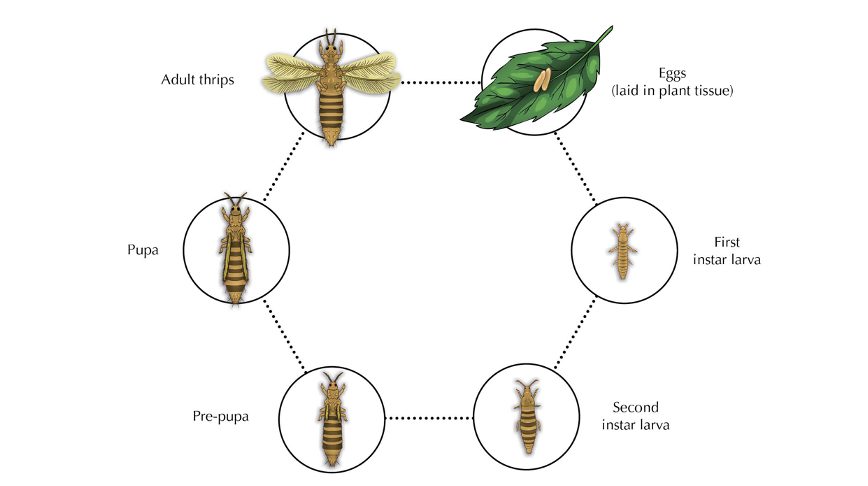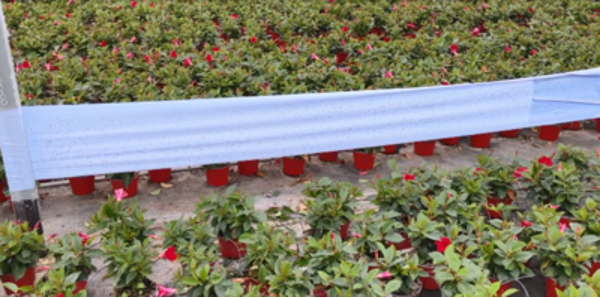Monitoring thrips as the first line of defence

In the glasshouse, ornamental and floral crops enjoy the best possible conditions for their growth: temperature, humidity, light, spacing and fertilisation are factors which, especially in structures with the highest levels of technological inputs, are carefully controlled and regulated according to the needs of the plant. Unfortunately, these conditions are also optimal for most of the pathogens and pests that affect floral and ornamental crops, which take advantage of this situation to proliferate and cause damage to the crops. As we maintain an ideal environment for cultivation for a good portion of the year, biological cycles of pests are extend for much longer periods than would happen under ambient/outdoor conditions.
Among the insects that commonly attack floral and ornamental crops, thrips, and in particular Frankliniella occidentalis (otherwise known as western flower thrips (WFT)) is present in glasshouses for a good part of the year, and can easily overwinter in our climate.
Damage can present itself in several ways: discoloration and sucking marks on flowers and open petals; deformation of buds and flower heads; pitting on the flowers due to oviposition. Following their trophic activity, silvery necrotic spots appear on the plant which can compromise the plant's ability to photosynthesize. Additionally, the insect can distort or stunt shoot growth and further reduce the value of the plant. The activity of the insect can also favour botrytis infections and the transmission of viruses.
F. occidentalis – WFT reproduces very rapidly under favourable conditions. With temperatures close to 25°C, the complete development cycle from egg to adult occurs in 13-14 days, but even with temperatures of 15°C the thrips are active and capable of reproducing. In favourable environmental conditions, thrips can complete 5-7 generations per year, one approximately every 15 days, but is potentially capable of carrying out up to 18.

In order to prevent thrips populations from multiplying uncontrollably, it is essential to identify the right moment in which to intervene. Once again, monitoring plays a key role in a successful defence strategy.
Due to the favourable climatic conditions typical of the protected environment, but also considering the occurrence of increasingly mild winters, it is important to start monitoring activities in a timely manner, and for some sites it would be expected year-round. Depending on the different crops, a monitoring system should already be in operation at the end of winter: this allows us to not be caught by surprise by sudden changes in climatic conditions such as an early start to spring.
When it comes to Thrips monitoring tools, chromotropic traps are certainly among the most widespread and easy to use. They consist of panels or adhesive tapes usually yellow or blue in colour: the latter are preferable for monitoring thrips. Attracted by the colour, they actively seek out the traps, they are captured when they interact with the glue on the surface and get stuck.
Constant monitoring of the traps and counting of the individuals captured will give us an indication of the attack pressure. The data obtained should be collected and analysed periodically in order to create a database that will allow us to have as precise a picture as possible of the trend of thrips populations both during the year and in the long term, you can also compare the data relating to different years.

It is important to remember that chromotropic traps constitute a support tool and do not represent a definitive solution. In fact, their use must always be accompanied by careful observation of the crop in order to identify any early outbreaks and have continuous visibility of the degree of susceptibility of the crop (young tissue, presence of flowers, etc.).
The measures just described will allow us to identify the appropriate moment to intervene promptly and with optimal results. We should consider how to react when a risk of a population surge emerges from monitoring and observation efforts, and therefore the need to intervene with a defence program.
As always lots of information available for you in the Expert Centre on the website. You can read more about the thrips life cycle here and also managing resistance in thrips here.

